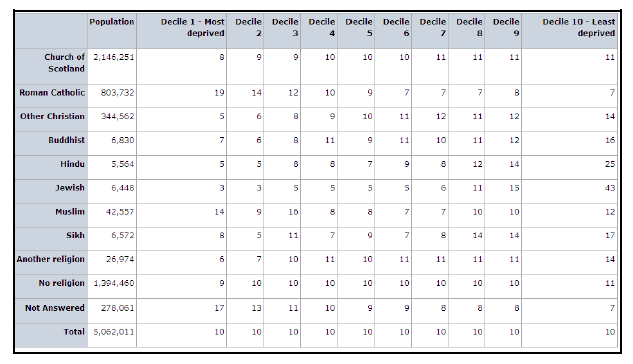Scottish Government Equality Outcomes: Religion and Belief Evidence Review
This evidence review was prepared to support the production of the Scottish Government's Equality Outcomes, with regard to religion.
5 POVERTY
5.1 This section looks at the distribution of wealth between religious groups, relative deprivation, and welfare reform.
Wealth
5.2 The EHRC Triennial Review explains that, due to sample sizes, we can only report on the median ranking of wealth (see Table 4)[20]. In terms of religion or belief, while Muslim and Buddhist groups have the lowest levels of wealth of all groups, this must be viewed in the context of the age profile of those populations. These groups have a significantly younger age profile than the other religious groups, including Christian, Hindu, Jewish and Sikh. However, further analysis is required to explain the outcome for the secular and 'other' groups.
Table 4: Total wealth inequality between and within religious groups in Britain, 2006/08 (Source: Analysis of the Wealth and Assets Survey, 2006-08)
| Median wealth (£) | Rank in the overall distribution | |
|---|---|---|
| GB Overall | 204,500 | 50 |
| Religion of Household Representative Person | ||
| Christian | 222,900 | 52 |
| Buddhist | 74,800 | 30 |
| Hindu | 206,100 | 50 |
| Jewish | 422,100 | 72 |
| Muslim | 41,600 | 23 |
| Sikh | 228,700 | 53 |
| Any other religion | 161,100 | 43 |
| No religion | 138,500 | 40 |
Deprivation
5.3 The Scottish Government's 2005 report on deprivation[21] is based on data from the 2001 census. It explains that, for the first time, the 2001 Census included a voluntary question on current religion and 95% of people answered the question. It warns that the religion results should be interpreted with care; the results should be considered in the context of small populations, differing concentrations in large urban areas (where there are more deprived areas) and other factors such as age structure of different groups, family composition and housing tenure.
5.4 Just over 60% of people who described themselves as Roman Catholic live in the Glasgow and Clyde valley (which covers East Dunbartonshire, East Renfrewshire, Glasgow City, Inverclyde, North Lanarkshire, Renfrewshire, South Lanarkshire and West Dunbartonshire), and this area also contains 70% of the 15% most deprived areas in Scotland.
5.5 However, it is interesting to note that in 17 of the 32 local authorities, the percentage of Roman Catholics living in the 15% most deprived areas of Scotland is higher than the percentage of Roman Catholics living in the local authority as a whole. Of the remaining 15 authorities, 13 have equal percentages in the 15% most deprived areas and the local authority as a whole. Two authorities, Aberdeen City and Falkirk, have a greater proportion of Roman Catholics living outwith the 15% most deprived areas.
5.6 For Roman Catholics, higher levels of limiting long term illness and lack of qualifications in the middle age groups may partly explain their concentration in the most deprived areas. The Analysis of Religion in the 2001 Census shows that the proportion of Roman Catholics with a limiting long term illness is higher than the Scottish average (for example, 41% of men aged 50 to pensionable age compared with 31% across Scotland). In the 2001 Census 32% of Roman Catholics aged 30 to 49 had no qualifications, compared with 25% across Scotland.
5.7 People who described themselves as Muslims are also more likely to live in both the 10% most deprived areas and the 10% least deprived areas (see Table 5). 14% of Muslims live in the 10% most deprived, and 12% live in the 10% least deprived, however, between seven and eight per cent live in deciles five and six.
5.8 The prevalence of Muslims in the most deprived areas may be explained by higher levels of limiting long term illness among older people; and high levels of economic inactivity and lack of qualifications among younger people. The Analysis of Religion in the 2001 Census shows that 50% of Muslim women aged 50 to pensionable age, and 70% of those of pensionable age to 74 years, had a limiting long term illness. This compares with a Scottish average of 28% and 42% in the respective age groups. Of all the Religions analysed, Muslims were also most likely to be economically inactive (65% of Muslim women were economically inactive - considerably higher than the Scottish average for women of 27%). Younger Muslim people aged 16 to 49 years were among the most likely to have no qualifications (22% of Muslims compared with 12% across Scotland in the 16 to 29 age group, and 45% of Muslims compared with 25% across Scotland in the 30 to 49 age group).
5.9 Many other people who described themselves as belonging to religious groups including Jewish, Hindu, Sikh and Buddhist are more likely to be living in the least deprived areas in Scotland.
Table 5: Percentage of each current religion group's population living in each SIMD decile, 2001 (Source: 2001 Census)

Welfare Reform
5.10 The Department for Work and Pensions (DWP) has published an Equalities Impact Assessment for the Universal Credit[22]. This explains that the DWP does not hold information on its administrative systems on the religion or belief of claimants, but also that it does not envisage any adverse impacts on these grounds.
Contact
Email: Social Research
There is a problem
Thanks for your feedback